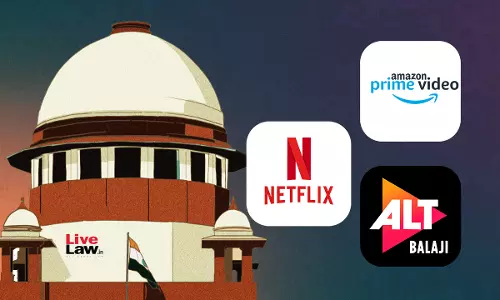If Basic Structure Doctrine Ever Goes, Then God Help This Country : Justice Nariman

Former Judge of the Supreme Court, Justice Rohinton Fali Nariman, today asserted that the basic structure doctrine is here to stay and warned about the dangers of doing away with this doctrine."And if by chance, if it ever goes, then God help this country," he said.Justice Nariman was speaking at an event of his book launch titled 'Basic Structure Doctrine: Protector of Constitutional...
Former Judge of the Supreme Court, Justice Rohinton Fali Nariman, today asserted that the basic structure doctrine is here to stay and warned about the dangers of doing away with this doctrine.
"And if by chance, if it ever goes, then God help this country," he said.
Justice Nariman was speaking at an event of his book launch titled 'Basic Structure Doctrine: Protector of Constitutional Integrity'. He began his speech by reminding the audience that April 13, 1919, was perhaps the "darkest day" in history when British General Dyer killed a large number of citizens at the Jalliwanabagh Bagh. He posed a question, would this kind of situation again occur in free India?
He added that the purpose of this book is to revisit the attempts made to do away with the basic structure doctrine but each time, it was unsuccessful. On the contrary, the doctrine was strengthened.
Justice Nariman recalled that the landmark Kesavananda Bharati had 11 judgments where the majority came up with what was known as the 'basic structure doctrine'.
"As soon as they [judgments] were handed down, we found that the only common measure among seven judges was something called as 'basic structure' and seventh judge, Justice Khanna, didn't agree with the other six judges in what they described as 'implied limitations'. Implied got struck in the throat. So, implied limitation was knocked out by six and J Khanna as well. However, as a matter of construction of the word 'amend' or amendment, ultimately seven judges said amend is used in narrow sense. They averted to Attorney General and Mr. Servai's concession, which is, you cannot repeal the Constitution simplicter." Justice Nariman said.
He added that interestingly, the four of six minority judges, all said that Article 31(C) which accorded primary to two Directive Principles over three Fundamental Rights and precluded judicial review, cannot be sustained but they didn't rely on the basic structure doctrine.
Another interesting fact which Justice Nariman further stated is that in the next judgment, which was apparently the test case for basic structure doctrine, the Indira Gandhi v. Raj Narrain, the four minority judges of Kesavananda Bharati relied upon the basic structure to do away with the Thirty-Ninth Constitutional (Amendment) which added Article 329A.
Since former Prime Minister Indira Gandhi was accused of election fraud, Article 329A(4) was inserted to the Constitution which stated that any appeal pending before the Court cannot be judicially reviewed.
Justice Nariman remarked:
"Bench which heard the case, it consisted of 4 minority judges in Kesavananda, and J Khanna which was the only judge of the majority [judgment in Kesavananda]. 4 minority judges said they were bound by Kesavananda ratio and each used basic structure to knock down this amazing Article. J Ray was forced to knock it down, saying it offends the rule of law. It can never be that the appeal is decided by applying no law. Each judge found some facet of basic structure to knock it down. J Khanna said free and fair election is a part of democracy, there is an election tribunal which goes into facts and there, nothing was gone into, no law is applied. J Mathew and J Beg said, constituent powers, whatever it is, can't exercise judicial powers before first granting judicial powers to itself. Finally J Chandrachud said it violates Article 14, which is a part of basic structure."
Justice Nariman remarked that after this, HM Servai, who was in the Opposition party in the original Kesavananda Bharti case and "doggedly" believed that there is nothing called a basic structure, completely changed his mind and became a supporter of the doctrine.
He further added, what was being considered prior to Kesavananda Bharti's case as outlandish, something which could not occur, had actually happened.
Attempts at undoing the basic structure doctrine and how it failed
What followed after this judgment were two unsuccessful attempts at undoing the basic structure doctrine, Justice Nariman stated.
Another interesting thing that happened, days after these judgments were delivered, within 3 days, a 13 judge bench was reconvened and this time, to say that basic structure should be revisited. CJ Ray reconvened the bench with a number of junior judges and we are told, he kept on saying, it was reconvened at the instance of Palkhivala's client. And Palkhivala's said, I wouldn't be out of mind asking for consideration of basic structure when I have succeeded on this. So, CJ was put in a corner and then, he [CJ] said, no but Tamil Nadu has asked for it. And then, Govind Swaminathan got up as Advocate General and said-we have done nothing of the kind, we support basic structure! then, he further got into a concern and said, then State of Gujarat has done it. And then, Gujarat's Advocate General got up and supported Swaminadhan's and said, I have done nothing of that kind.
Justice Nariman pointed out there was an internal "revolt" within the judges and abruptly, on the second day of the arguments, Chief Justice Ray walked into the Court and said that the bench is dissolved!
"First attempt to undo Kesavanada failed. Second attempt was Constitution 42th Amendment where by adding two sub-clauses to Article 368, the amendment specifically said there is nothing like basic structure and no constitution amendment can be challenged in a court of law. This was struck down in the celebrated Minerva Mills case saying that suppose, there was procedural infirmities and not substantive, suppose 2/3 member of Parliament present and voting was in fact not present, even then, the Court cannot say anything. So, for that reason it is bad."
Justice Nariman concluded by stating that Nani Palkhivala, who fought the Kesavananda Bharati's case had nothing with him except an article written by German Professor, Dietrich Conrad.
The event was also presided over by Justice KV Viswanathan, judge of the Supreme Court; Justice AK Sikri, former judge of Supreme Court and Senior Advocates Arvind Dattar, Kapil Sibal and Dr Abhishek Manu Singhvi.
The event can be watched here.




